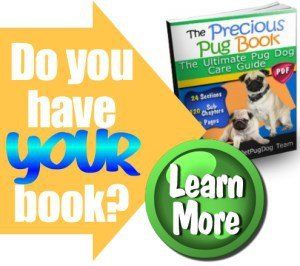Discipline

How to Discipline a Pug
Overview
It would be nice if our Pug puppies and dogs would automatically listen well at all times, however this certainly is not usually the case. While there are some things that a dog can instinctively know, many things do need to be taught. And part of teaching a puppy or older dog is the chosen method that is used for discipline. Whether your Pug is biting, nipping, destructively chewing, barking, excessively licking you or having bathroom accidents… the way that you correct your Pug will play a huge role in how well you can teach him right from wrong.
In this section we are going to cover:
- Commonly used methods of disciplining a dog and exactly why these techniques do not
work
- The 3 things that a Pug needs to truly learn something
- The most effective way to discipline your Pug for fast success
Discipline Methods that do NOT Work and Why
There are many ways to discipline a dog; however the problem is that many of the commonly used methods rarely work. If you use any of these techniques, things can backfire. In addition, new issues can arise.
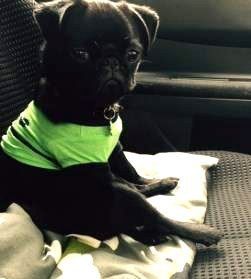
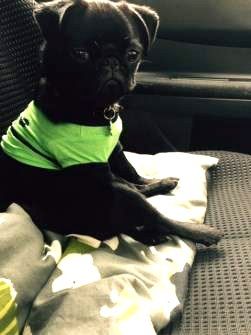
Timothy
Photo courtesy of Diane Darch
Never do physical intervention, slapping the Pug's bum or tapping the nose- Some owners will slap a puppy's rear end or thump a dog's nose as a way to 'spank' a dog and let them know that they did something wrong. Whether you use your hand, a newspaper or another item that you deem 'safe' this is a form of physical abuse since there is no clear line of what hurts and what does not.
Having the intention of hurting a dog is a cruelty to animals. And if your intention is to simply startle the dog into listening, this will not solve that the original issue that you are trying to correct. In addition, dogs that are hit in any fashion may have eventually have increased aggression.
Never yell - When things seem out of control, it's easy to lose your cool. Yelling at a Pug will often scare him and this may appear to work at first. After all, a dog that is screamed at will stop what he is doing…however he will have no idea why you are yelling or what you are saying. Being shouted at will increase his anxiety and stress level, which decreases his ability to focus and learn.
Never give timeouts in severe isolation
- There are two types of isolation discipline methods: physical and social. Physical isolation involves placing the Pug into a small area such as a crate that is away from other family members (both human and animals). This does not work, because when a dog is punished in this way, he will often become scared and anxious. He will have no clue as to why he has been 'locked away'.
A Pug will be under duress during this time and will only be focused on getting free, not on learning what was expected of him.
Social isolation is a different type of discipline and we will go into that ahead.
Never take away a toy
- Dogs have very few possessions in comparison to us humans. They have their beds, their food and water bowls and their toys. Beds are for comfort, food and water of course is for survival and toys are a dog's most prized possessions as they can become very attached to them. Can you make a Pug listen by taking away a favorite toy?
This does not work because one of two things will happen: 1) If the Pug cares about what just happened, it moves the dog into a mindset of wanting to have his toy back, when this time could be better spent actually teaching the Pug what he did wrong and what he should be doing instead or 2) Some Pugs will take this in stride because there are other toys to play with and if you take away all of his toys, he may very well think you are just playing some sort of odd game. Again, there are better ways to discipline your Pug that actually work well.
Never rub a Pug's nose in his feces or urine
- Far too many people think that this works when a dog has a bathroom accident and this may be due to copying what they saw their parents or grandparents doing in the past. Before the wonderful invention of computers and the transition of having them everywhere (yeah, there was a time like that!), people didn't have instant access to information. Sure, some dog owners would purchase training books, however the majority of them just did what they saw others do due to a lack of knowledge regarding proper training methods. This is an old-fashioned punishment that can scare the heck out of a dog or confused him and it does not work.
3 Things a Pug Needs for Discipline to Work
Dogs do not automatically know what is expected. While it may make perfect sense to you that your Pug should only pee or poo in a designated outdoor area, your puppy or dog will not know the difference between that spot of grass and the carpeting in your living room unless he is clearly taught.
And while it may seem logical to you that your Pug should not chew on the leg of the kitchen table, he has no idea why
that is wrong, but chewing on a toy is okay, unless it is clearly taught to him.
The reason why all of the above listed punishments do not work, is because while they may startle a dog, or scare him or even make him know that he misbehaved, they do not show him what he should do instead.
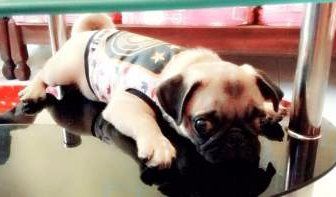

Bubloo, 9 months old
Photo courtesy of The Krish's Family
In addition, for a Pug to be well-behaved, he needs to respect his leader, which will cause him to want to listen. If a dog is punished in a way that causes fear, he will be afraid of his leader which is not the same as respecting him.
Proper discipline for potty training and chewing/nipping/ other actions involve 3 steps:
1) Limit.
If a Pug has full run of a house and access to everything in it, he will have so many choices that he's bound to do things wrong. With 4, 5 or 6 rooms to possibly pee or poo in, if he has to go, surely he will not automatically wait until he is taken out or go right over to pee pads. If he has access to laundry piles thrown on the floor, how will he know that those are not 'toys' left out for him? Here are some good guidelines to follow:
•
Any time that a Pug puppy is not being very carefully watched, he should be restricted to a controlled area. One of the best methods is to use a quality portable indoor playpen that is large enough for toys, food & water, a quality bed and pee pads. This should be placed in well-lit room that is commonly used by the family such as the kitchen or living room.
•
For bathroom needs when a Pug is home alone, if the puppy is in his pen, he will not purposefully pee or poo on his toys, water & food bowls or bed, so if the only other area available is his pee pads, the Pug is more than likely to use them. In cases of a Pug moving the pad onto his bed (some do this as if it is a blanket) or chewing it up, it can help to 1) duct tape the pad securely in place (works with hardwood or linoleum floors) or 2) forgo the pad and simply place the gates in the kitchen where the floor is easy to clean or on top of an appropriately sized cut-out piece of linoleum (this can be purchased at a home supply store). Keep in mind that housebreaking is a temporary phase and by the age of 9 months or so, a puppy can hold his needs for 8 hours or so while you are at work.
•
It IS important to NOT keep him in his pen too often when you are home… A Pug needs to roam the house and to inspect all of the (safe) objects in the house. If not, how else is he to learn right from wrong? However, this should be done with the owner as his guide and along with discipline methods as shown ahead.
•
Limit what the Pug has access to. An email from an owner comes to mind that let us know that his young Pug puppy
that was in his teething phase, kept chewing his shoes. He had a collection of running shoes that he liked to place in a row near the front door for easy access when he'd leave the house. Any time that he turned his back on his Pug, the puppy would scamper over to the shoes and start chewing on them. The question was: how to discipline the puppy to stop doing that.
While he could have put a lot of effort into teaching the lesson between those shoes and toys and it would have eventually worked… it was a lot easier to simply move the shoes to a shelf or onto a stand-up shoe rack where they were no longer accessible. The lesson here is to choose your battles wisely, especially with a teething puppy. Not only should the house be puppy-proofed, all objects that can be tucked away, should be. Leaving a Pug with tons of chewing options aside from toys is the canine equivalent of letting a child loose in a candy store.
Non-movable objects such as furniture legs, that dogs for some reason love chewing on, can be sprayed with a safe deterrent spray; apple bitter works well for this.
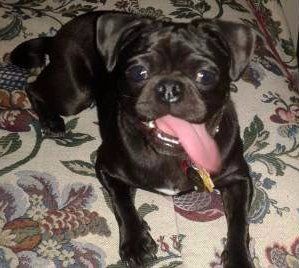

Velvet, 10 months old
Photo courtesy of Abby
2) Stop.
You do want a method to stop your Pug from doing an action that is wrong. There are 2 ways to do this.
1.
In some cases, an effective discipline method is to clap loudly. This works well for house training and chewing issues. Clapping is usually enough to startle a Pug momentarily, which is all that you need as long as you are ready for the next discipline step. You can add a firm 'No!' to this, however do be sure to say this with authority while not actually yelling.
2.
For nipping and other such behavior, if a clap does not work, simply standing up from a sitting position may be enough to stop a Pug, since you are limiting his ability to reach you. If the puppy is really out of control, this would be the time to instill the social isolation discipline that we touched on above. This involves placing him in his playpen for a short while. In either case of standing or putting him in his pen, part of this will involve ignoring him.
You may wonder how in the world ignoring a dog will teach him anything.
To a dog, his humans and any other animals in the house are his 'pack' and being part of the pack is everything… It is his safety, his security and his family. When a dog is ignored, he will start to worry that he is being banned from his pack and this will cause him to rethink his behavior. You do not need to do this for very long… some Pugs notice right away and others take much longer to figure out that they are not being spoken to, etc…. just wait until your dog has noticed and allow 5 to 10 minutes to pass from that point.
3) Teach.
A dog will never learn what he is supposed to do, unless it is shown to him. While words such as 'No' can cause a Pug to pause, the most important part of discipline is to clearly show your Pug what you expect. Just as important, a dog needs to understand why he should do it. Give a Pug motivation and a reason to follow the rules, and you'll find success every time.
It's really that easy: Show what
to do and why
to do it.
Here are some examples:
• If your Pug nips at you, give a short, sharp 'No" and then make it clear that it is unacceptable by rising up or by placing him in his pen and then not making eye contact or speaking to him. Once he has noticed that he is being 'temporarily banned from the pack' as described earlier, and you let 5 minutes go by, allow him access to you again. If he nips again right away, he is ignored again and this time for the maximum of 10 minutes. If he behaves well, after just one minute of good behavior reward him with praise and a small treat (if he needs extra motivation).
• If your Pug starts to pee in the living room, clap your hands loudly and immediately bring him (carry him if you must) outside to his designated bathroom area used for housebreaking. Say a word that he can learn to associate the action with such as "Bathroom"… and as he is peeing, give praise that includes the affirmation of what he is doing by saying "Good, bathroom. Good boy, you're going to the bathroom!" When he is done, finish with an enthusiastic pat and/or a small treat.
• If your Pug is chewing on something that he should not, clap loudly so that he will pause. Immediately offer him a tempting chew toy. As soon as he mouths it, praise him in a happy voice as if he is doing the most wonderful thing in the world. While it may seem a bit silly to act so happy that a dog is playing with a toy, when you are teaching right from wrong,
Pugs learn best if an appropriate action is met with tons of enthusiasm and delight. Once the dog has had a few weeks to learn what is expected, you can tone things down and give 'normal' positive reinforcement with a simple 'Good boy' or 'Good girl'. Do make a note to apply apple bitter spray (or other safe deterrent) on any non-movable item that seems to be too tempting to your Pug for him to leave alone.
*** Two really great deterrent sprays, to stop chewing on any sort of household items are:
Important Discipline Facts to Keep in Mind
1) Canines have both short and long term memories. Long term memories include learned commands, familiar faces and other such elements that have been instilled each day. As long as a dog has the same incoming information, these are things that he will not forget. This is why teaching a dog a trick or disciplining chewing on socks by offering a toy instead will work in the long run, as the repetitive action moves from short term to long term.
Short term memories involve random actions or events that are not reoccurring and most dogs can only remember these sorts of things for a maximum of 5 minutes. Therefore, disciplining a Pug 5 minutes or more after a deed has been done will have no effect. If 15 minutes have passed and you have discovered that your Pug took a roll of toilet paper and destroyed it… or two hours went by after he went pee square in the middle of your bed, no discipline methods will work.
The only thing to do at that point(after cleaning the mess) is to make a note to limit his ability to repeat the action (keep the toilet paper out of reach and keep your bedroom door closed).
2) Positive reinforcement works better than negative reaction.
While your "No's" will have some effect and giving a time out and ignoring a nipping puppy will give him reason to question his actions… what Pugs respond to most are their owner's praise. This breed is incredibly loyal and bonds super close with his humans. To hear happy words of encouragement is what motivates a Pug to do certain actions and behave a certain way. Cheer your Pug on… when he goes to the bathroom in his designated spot treat this as if he just picked out a winning lottery ticket for you (about a $100 dollar prize, not a million… because that's just overkill)…
Smile wide and be happy when your Pug goes for a toy instead the corner of your favorite throw rug… Show your Pug how happy you can be when he does certain things and he will want to keep pleasing you. A happy owner is a happy Pug.
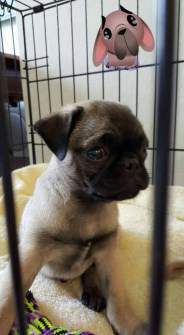
Gizmo, 10 weeks old
Photo courtesy of the Oliveira's Family
3) Reaffirm good behavior.
Once all training has been done, it's easy to take for granted that a Pug listens well and behaves appropriately. Many owners feel that they can finally relax and that they will never again need to discipline their dog. However, keeping in mind the short VS long term memory that we discussed earlier, lessons can be forgotten if a dog is not reminded. It only takes a moment to give a praiseful "Good, boy" or "Good, girl" and this should be done on a regular basis.
Summary
Remember that discipline should be done lovingly and with the attitude that your Pug is a student, willing to learn but much better able to do so in a safe, caring environment where mistakes will be forgiven and proper ways of behaving will be taught with kindness and understanding.
Check out The GIANT Book of Pug Care- It takes a giant, detailed and breed-specific book to confidently care for a Pug through every stage of his/her life. Now you’ve found it!
Related:
How to Train a Pug to Stop Begging
PetPugDog.com Copyright 2019. All rights reserved. Privacy Policy
We are a participant in the Amazon Services LLC Associates Program, an affiliate advertising program designed to provide a means for us to earn fees by linking to Amazon.com and affiliated sites.

